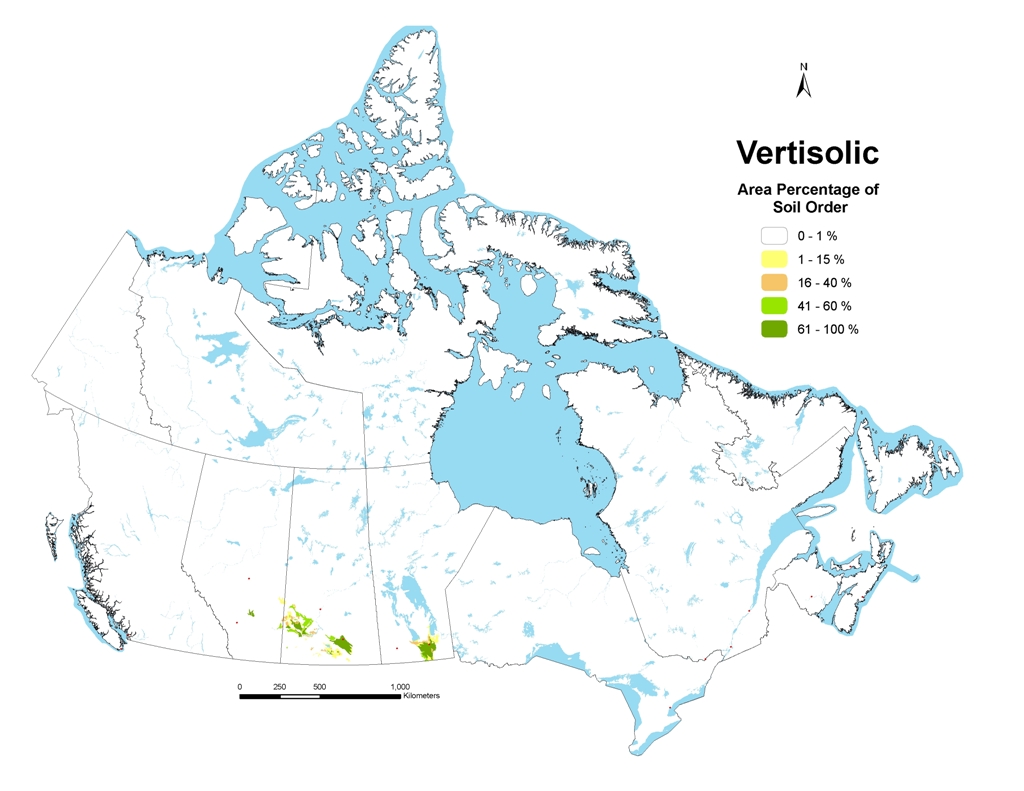Introduction Soil Science and Soil Resources
Vertisolic Soils
Vertisolic soils are found on parent materials high in clay (i.e., greater than 60 % clay) throughout the Prairie Ecozone and also have a very limited extent in other regions of Canada. These parent materials were deposited in lakes that existed during the retreat of the last (Wisconsian) glaciers between approximately 17,000 to 9,000 years ago.

Lake (or laustrine) sediments high in clay were often deposited in the deepest parts of these lakes. The beds of the glacial lakes at these deepest points were typically very flat, and Vertisolic soils are associated with these level or near-level lacustrine surfaces. Soils high in clay are often referred to as “heavy” soils compared to “light” sandy soils; try digging a soil pit in each type of soil and you’ll understand why these terms are used!
Clay minerals have a layered structure. If the bonds between the layers are weak the mineral structure can absorb water when wet (causing swelling of the clay) and lose this water from their structure when dry (causing shrinking of the clay). When the mass of soil dries out, cracks can appear at the soil surface that often extend down 1 meter or more. When the soil subsequently gains moisture and swells, these cracks fill in with soil from the soil surface and upper parts of the profile. This mixing of soil material is the one of the characteristic soil-forming processes of the Vertisolic order. The horizons that result from this mixing are inverted of material and are called vertic horizons. They are assigned a lower-case v suffix (e.g.Bv, Cv). The mixing causes horizons in these soils to be weakly developed compared to comparable Chernozemic soils and recognition of distinct horizons can be difficult.
The other characteristic feature of these soils occurs along the fractures in the soil caused by cracking and shifting of the soil mass. As a mass of soil is displaced along a crack, the face of the mass can become very smooth and polished. These polished surfaces are called slickenslides, and the horizons they occur in are given an ss suffix (e.g. Bss, Ckss, Cgss). These horizons usually occur under the layer of highest mixing (i.e., the v horizon occurs closer to the surface than the ss horizon).
Great Groups
Two great groups of the Vertisolic order occur. Both have B and/or C horizons with evidence of mixing (Bv or Cv) and polished surfaces along fracture planes (Bss or Css). The differences between them are based on how well expressed the A horizon is.
Humic Vertisol Great Group
These soils occur in the moister, central part of the agricultural region and have an Ah (or Ap) horizon greater than or equal to 10 cm thick and a darker A horizon than the Vertisol great group. The colour value of the horizon must be less than 3.5 (dry). In the Prairie ecozone they would be associated with the Black soil zone.
Vertisol Great Group
Soils of the Vertisol great group have an A horizon less than 10 cm thick that can be difficult to distinguish from the underlying B or C horizon. The colour value of the horizon is greater than or equal to 3.5. In the Prairie ecozone they would be associated with the Brown and Dark Brown soil zone.

